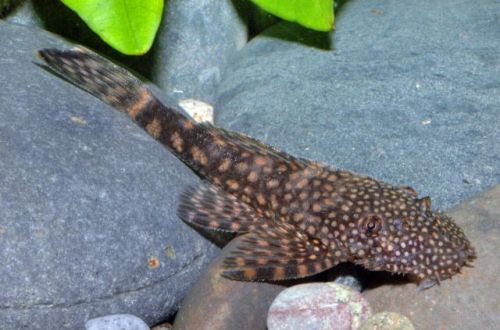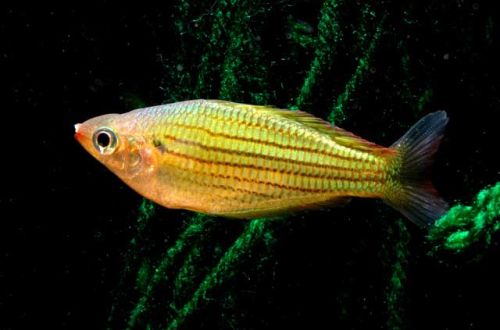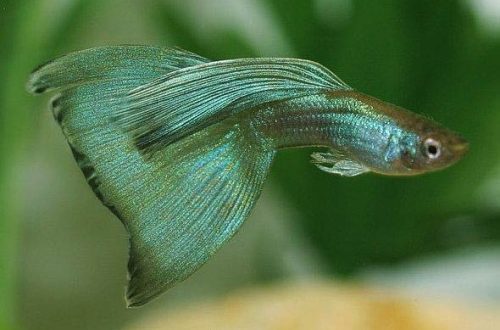
Chromis red
Red Chromis or Red Stone Cichlid, scientific name Hemichromis lifalili, belongs to the Cichlidae family. Beautiful bright fish, quite easy to keep and breed. The only significant drawback is excessive aggression during the spawning period, so it is not easy to find suitable neighbors in a small aquarium.

Contents
Habitat
It comes from the Congo River basin from the territory of the Democratic Republic of the Congo of the same name. It lives in streams and rivers in regions with a slow current. Thanks to the multi-membered thresholds, the water is rich in dissolved oxygen.
Brief information:
- The volume of the aquarium – from 70 liters.
- Temperature – 23-26°C
- Value pH — 6.0–7.8
- Water hardness – soft to medium hard (4-15 dGH)
- Substrate type – sandy or fine gravel
- Lighting – subdued
- Brackish water – no
- Water movement is weak
- The size of the fish is 10–15 cm.
- Meals – any
- Temperament – quarrelsome, aggressive during spawning
- Keeping in a formed male/female pair or singly
Description

Adult individuals reach a length of up to 10–15 cm. The color is orange or red with small bright blue specks. During the spawning season, the colors become more saturated. Sexual dimorphism is weakly expressed, it is problematic to distinguish a male from a female.
Food
Live or frozen foods are preferred (bloodworm, daphnia, brine shrimp, etc.) with herbal supplements, such as spirulina flakes. High-quality dry food with a high protein content can serve as an excellent alternative.
Maintenance and care, arrangement of the aquarium
The optimal size of the aquarium for one pair of fish starts from 70 liters. The design must provide for a sufficient number of shelters (caves, snags, etc.) and areas with dense vegetation. Chromis red often digs in the ground, so use a sandy fine gravel substrate, for the same reason, live plants are planted in pots to avoid pulling them out or damaging the roots.
Water conditions have slightly acidic pH values with low to medium hardness (dGH value). To maintain a high concentration of dissolved oxygen, provide an effective water aeration system and regularly clean the soil from organic waste, which, during decomposition, actively absorb it during chemical reactions.
Behavior and Compatibility
Territorial and very aggressive fish during the spawning period. The rest of the time it can get along quite peacefully with other calm species of a similar or slightly larger size. Red chromis are monogamous, form a permanent pair, which persists throughout their life, while other relatives are extremely unfriendly, as a rule, killing weak fish.
It is worth noting that in order to form a pair, it is not enough to place two adult males and a female in an aquarium; most likely, one of them will die from the persecution of the other. Pairs are formed as they mature, when young fish grow together in a group of at least a dozen individuals.
Breeding / breeding
During the mating season, as noted above, Chromis become overly aggressive and can even attack the aquarist’s hand if it is immersed in water, so other fish must be temporarily relocated to another aquarium. The male is usually very persistent in the process of courtship and if the female is not ready, then she will need reliable shelters to hide from her partner’s obsessive courtship.
A suitable place for laying is any flat surface, the female can attach eggs even to glass. In total, up to 400 eggs are laid. The incubation period lasts about 48 hours, all this time the female is near the masonry, and the male, being at a distance, digs several holes. When the fry hatch, the female will alternately carry the brood from one hole to another for several days until the fry can swim on their own. In total, parental care lasts about a month, after which it is advisable to transfer the fry to a separate tank.
Fish diseases
The main cause of most diseases is unsuitable living conditions and poor-quality food. If the first symptoms are detected, you should check the water parameters and the presence of high concentrations of hazardous substances (ammonia, nitrites, nitrates, etc.), if necessary, bring the indicators back to normal and only then proceed with treatment. Read more about symptoms and treatments in the Aquarium Fish Diseases section.





